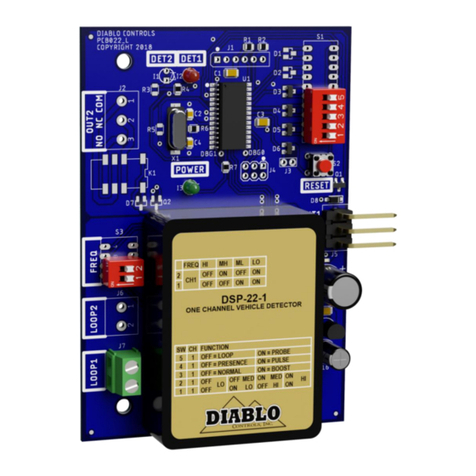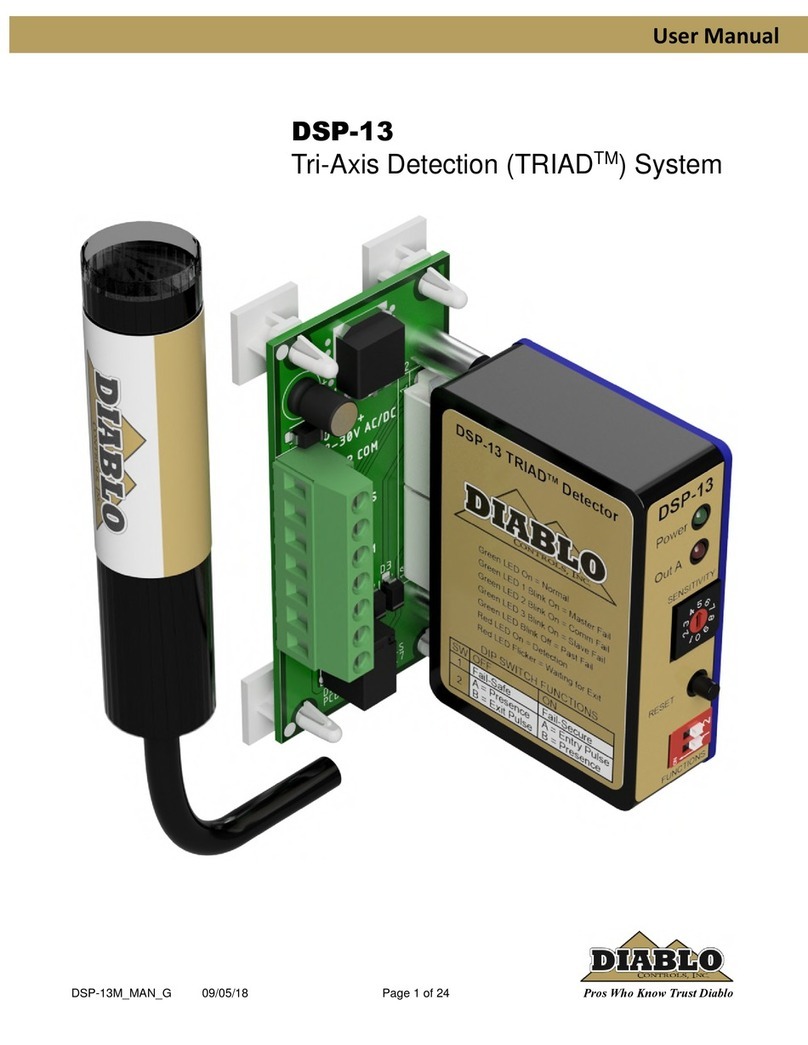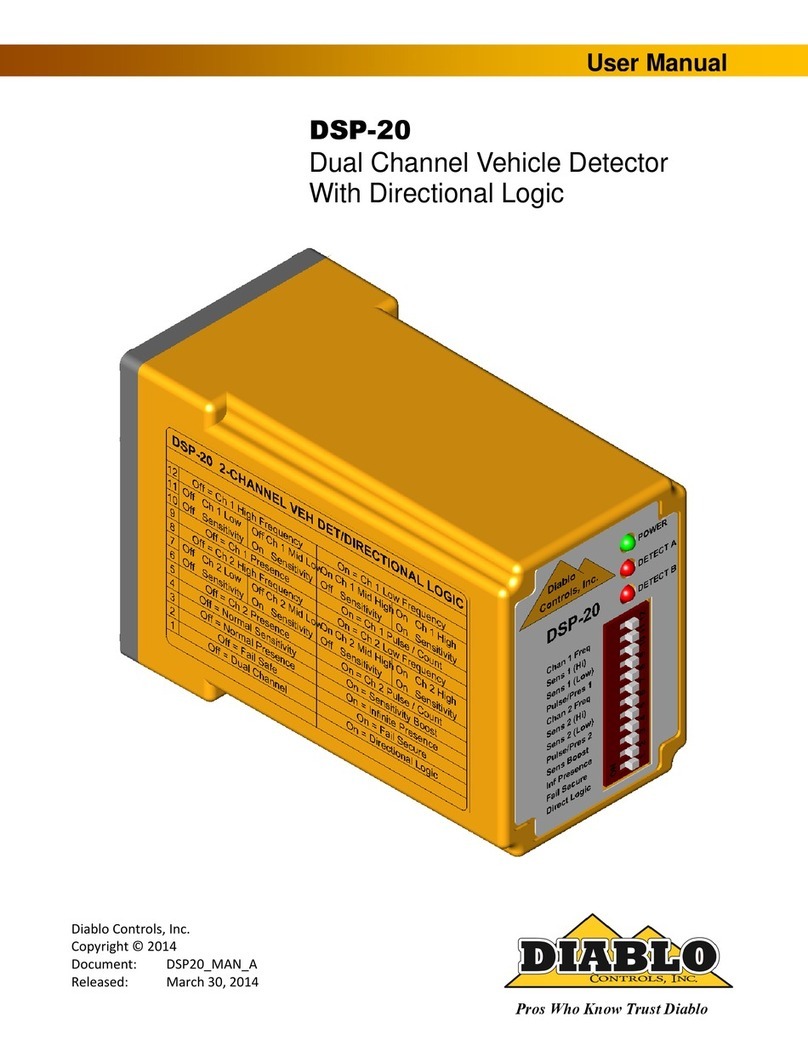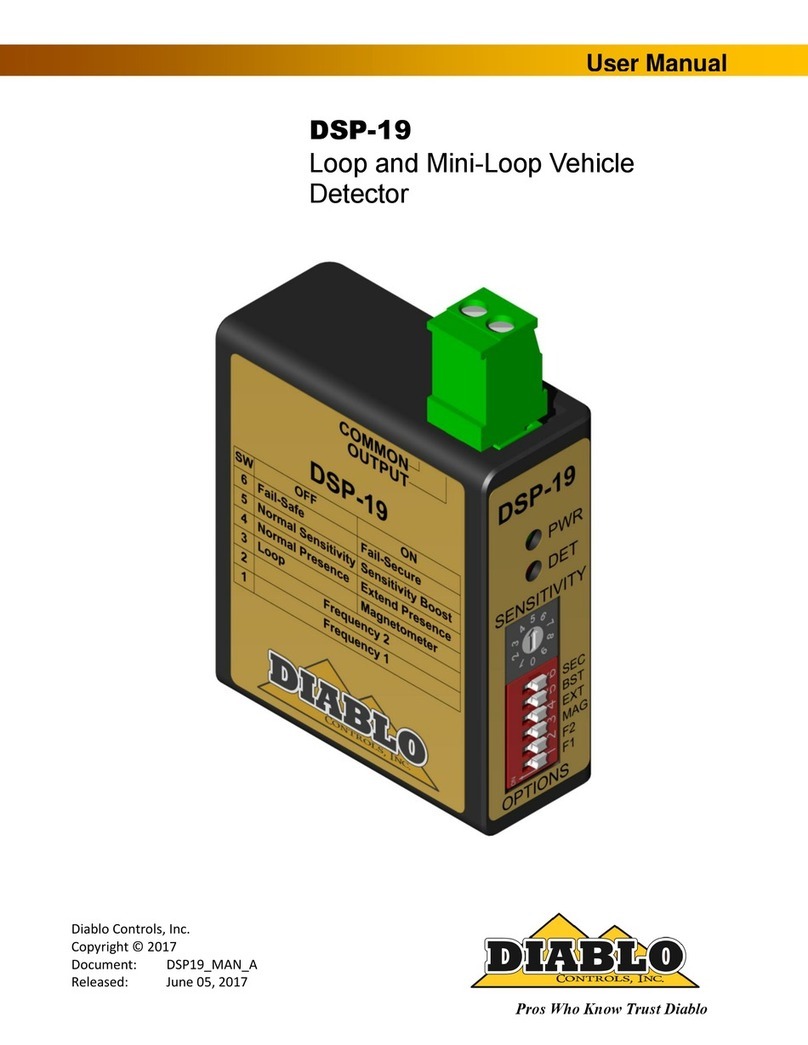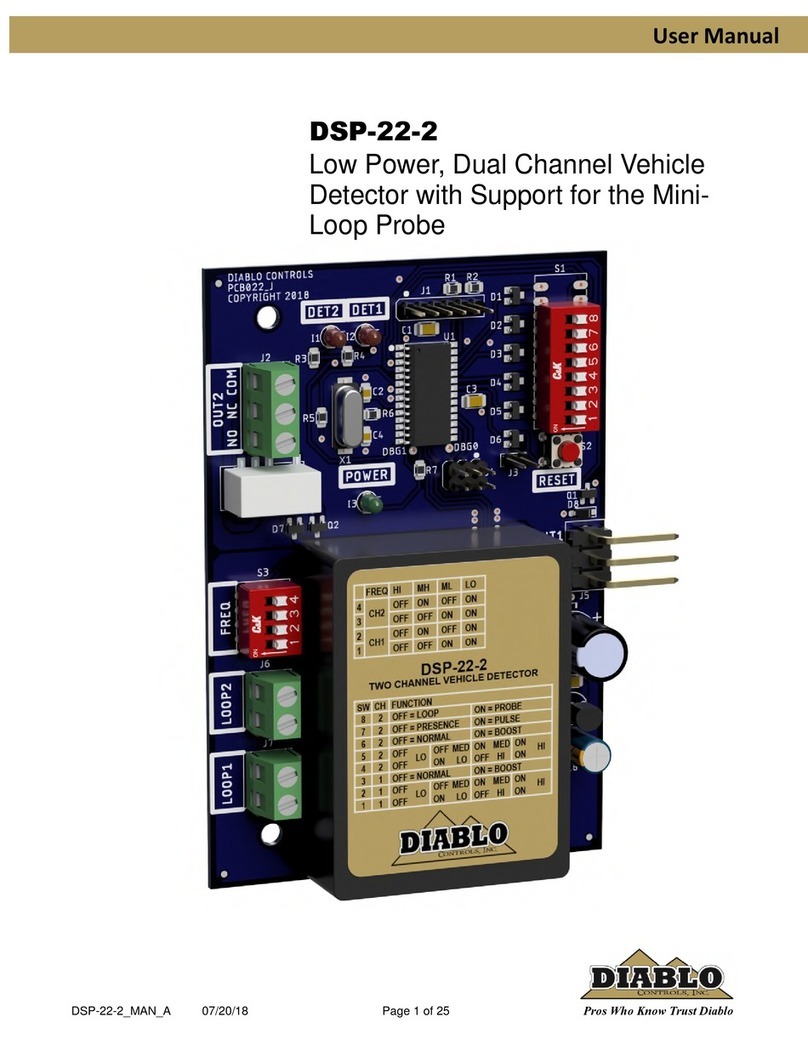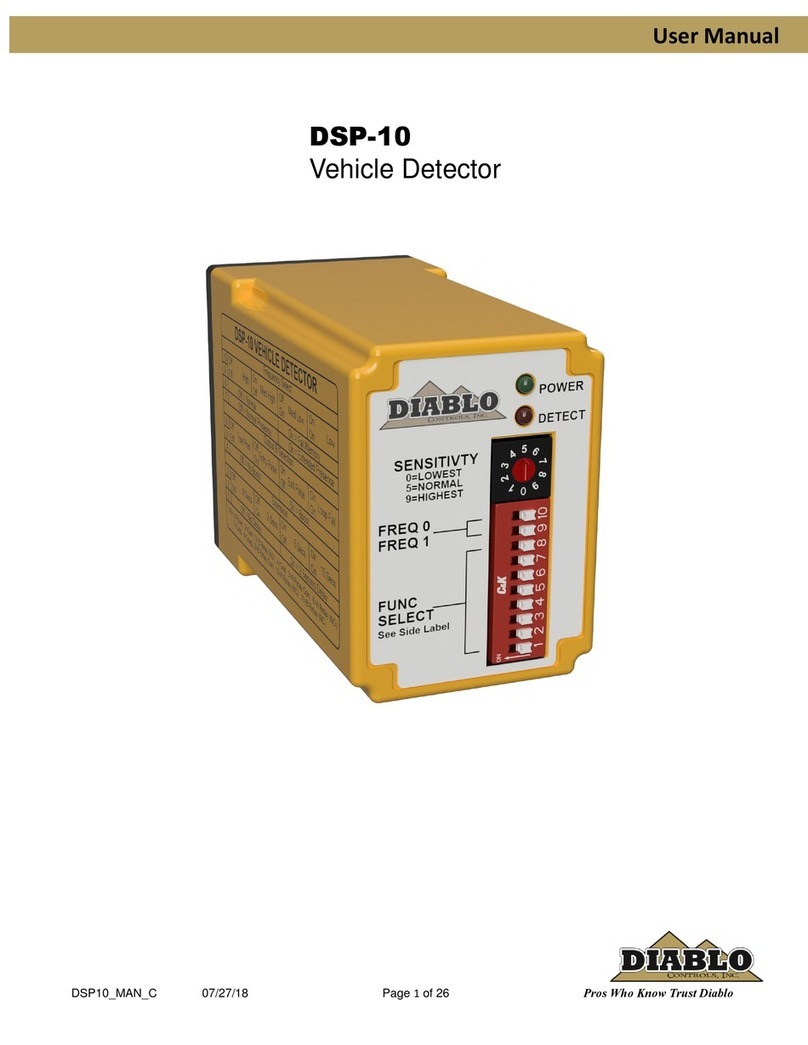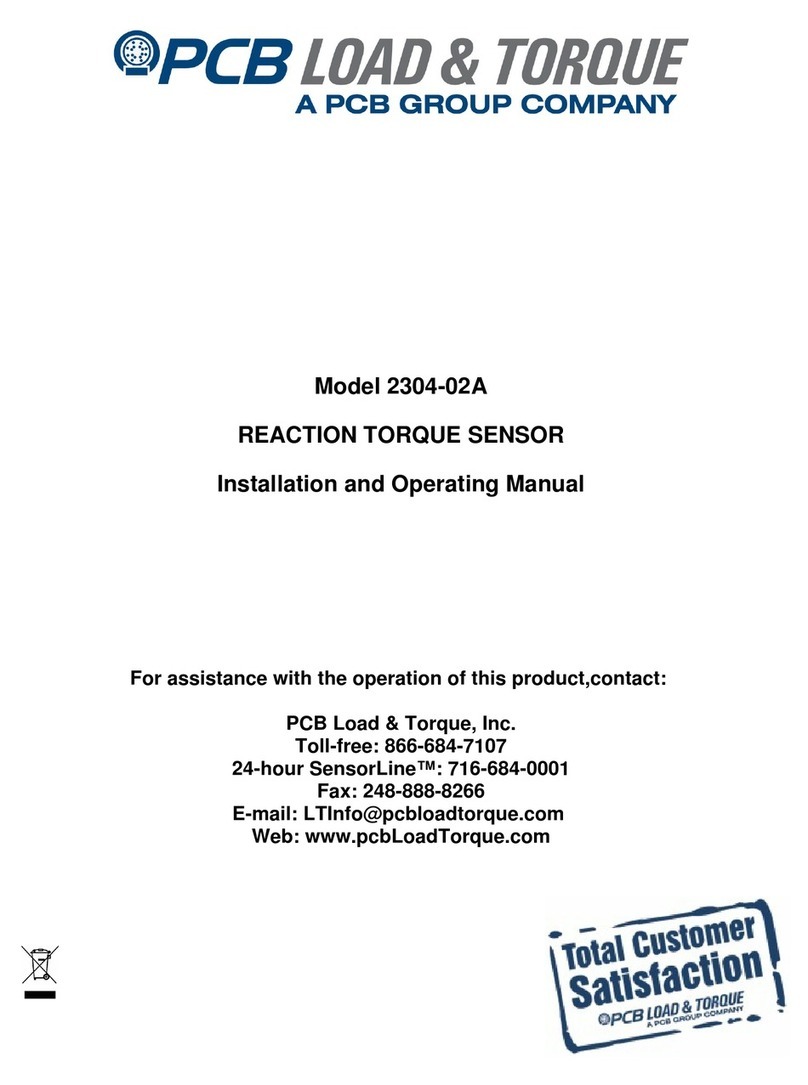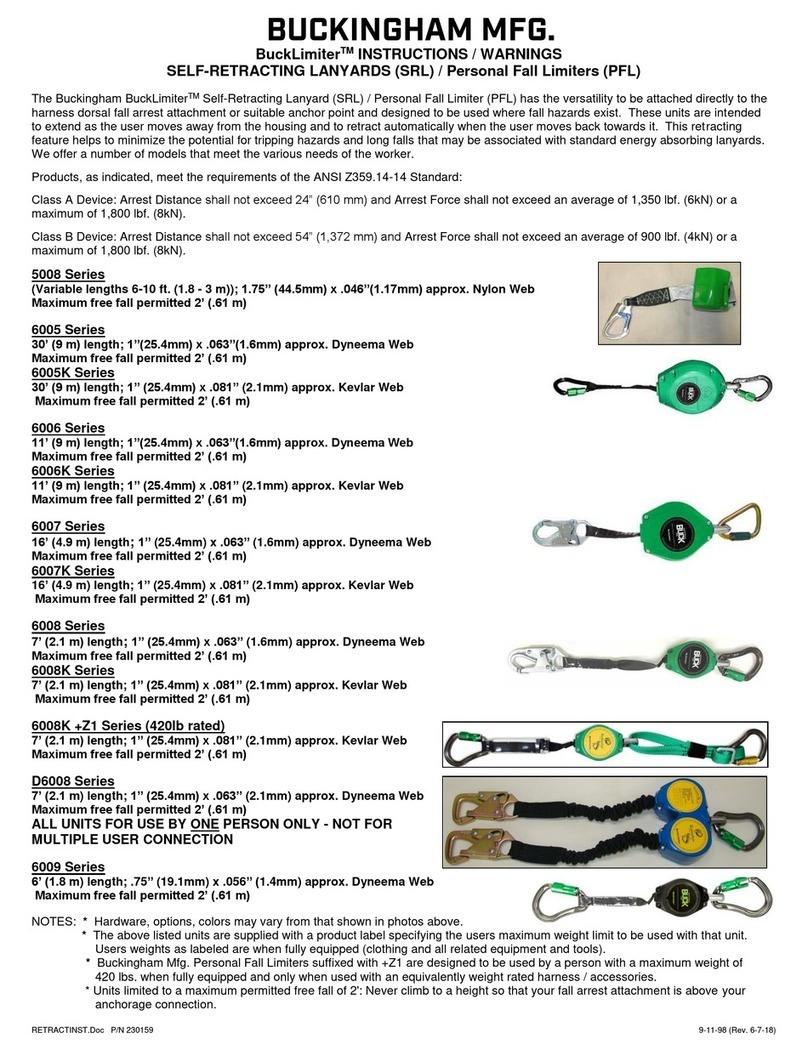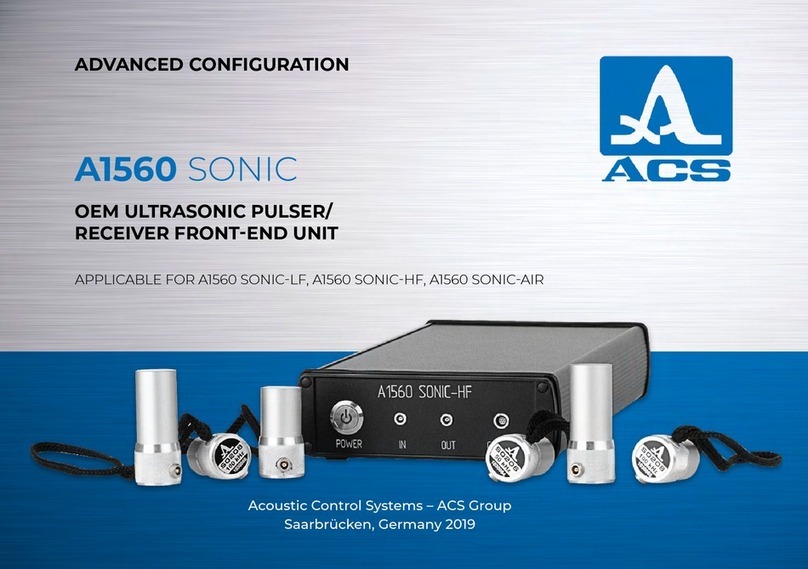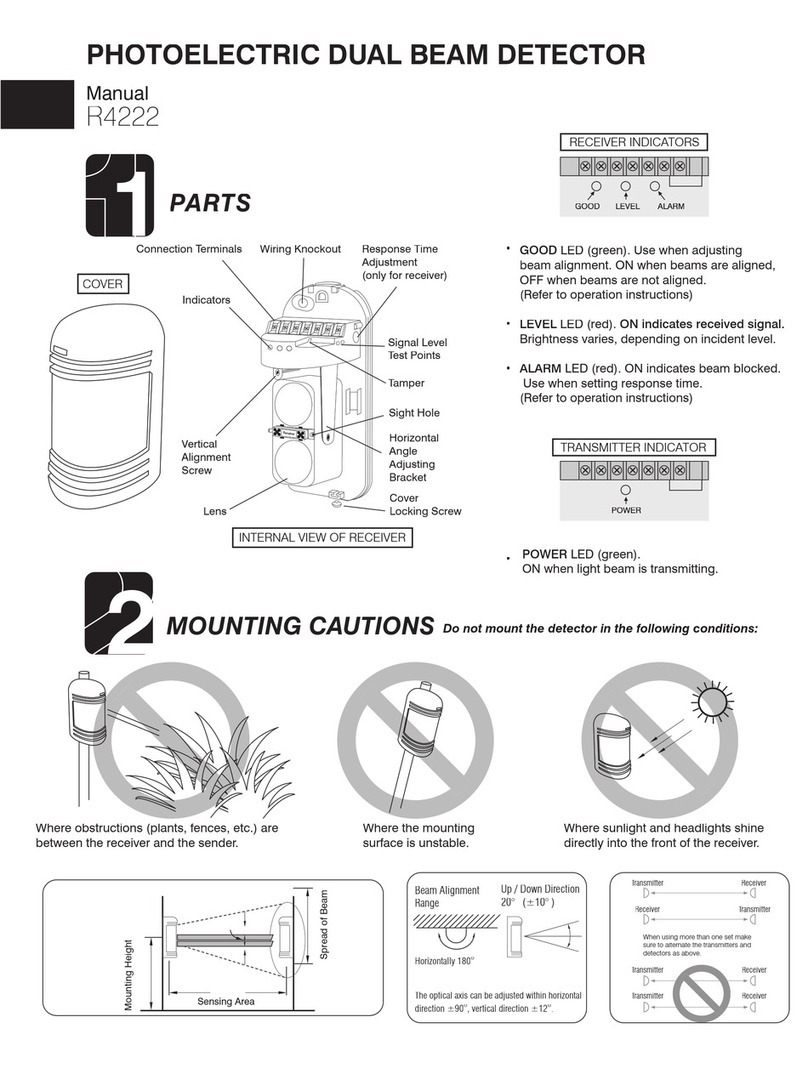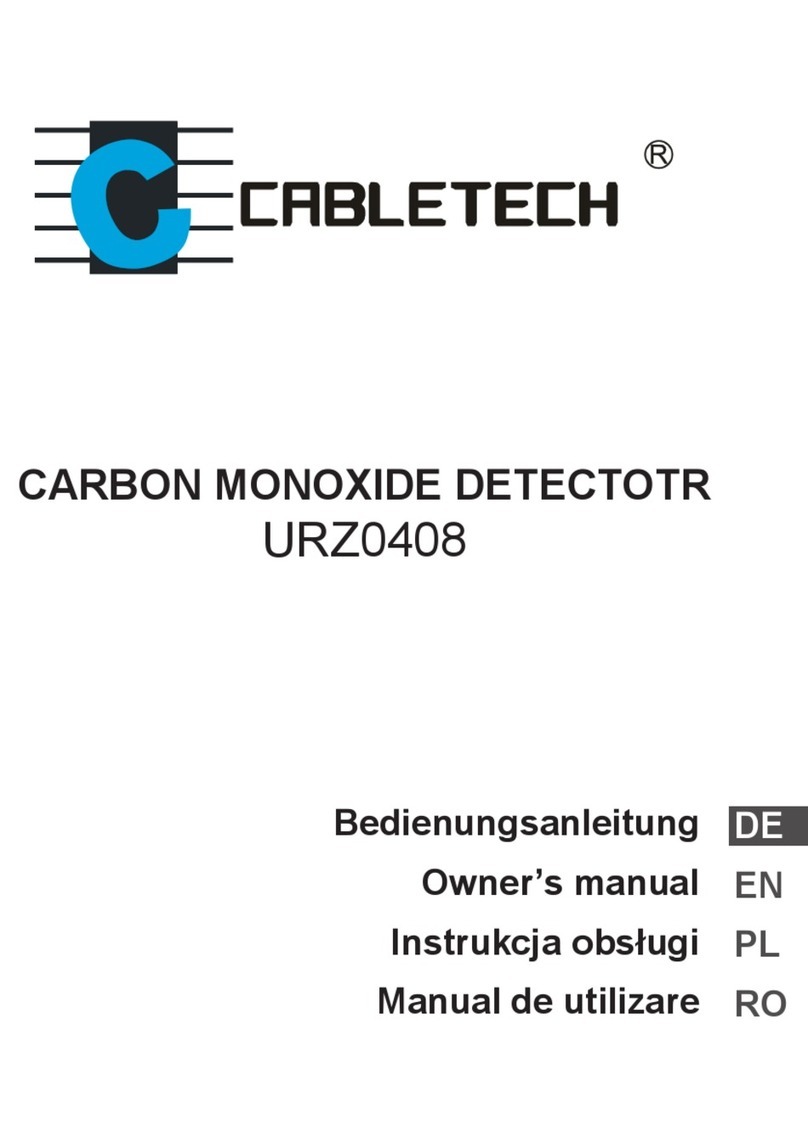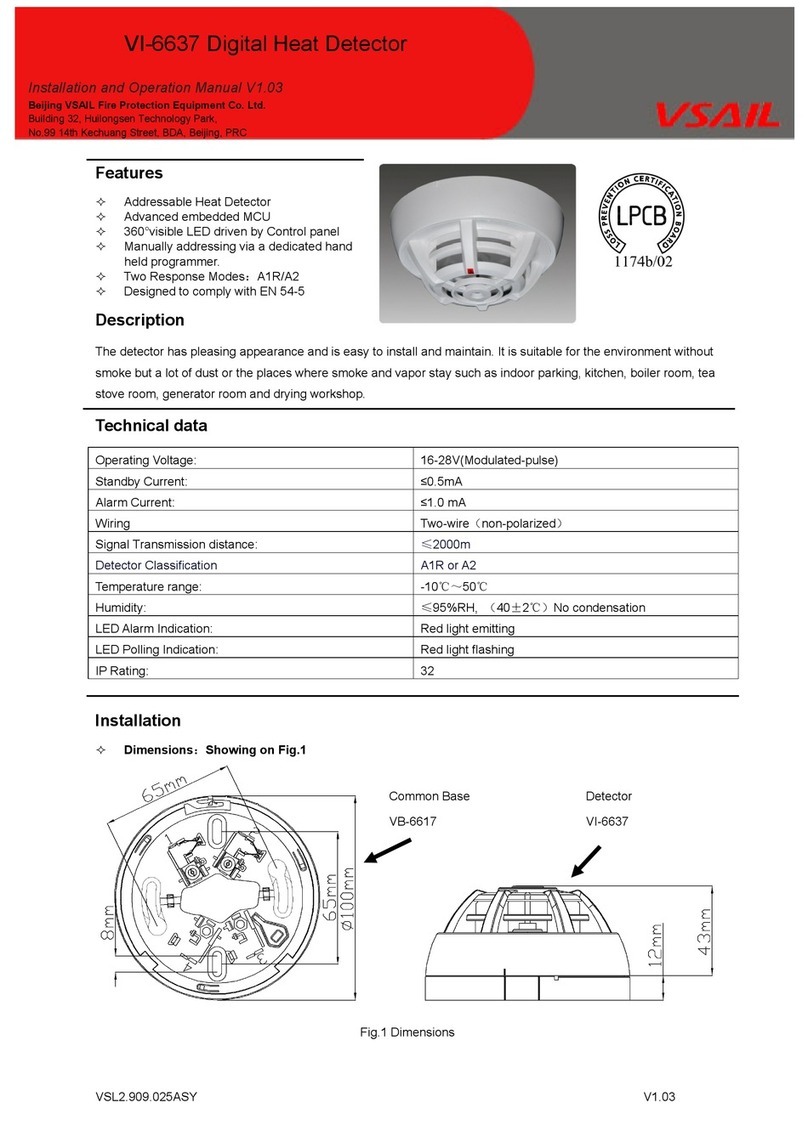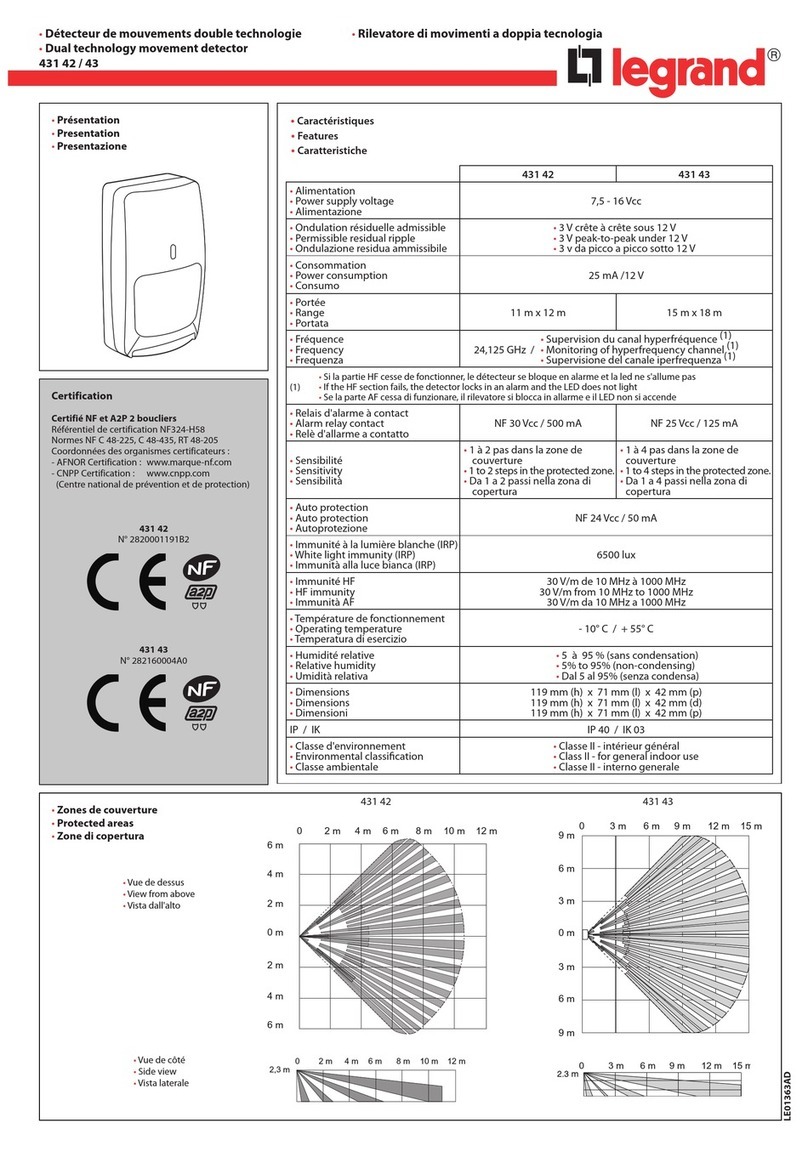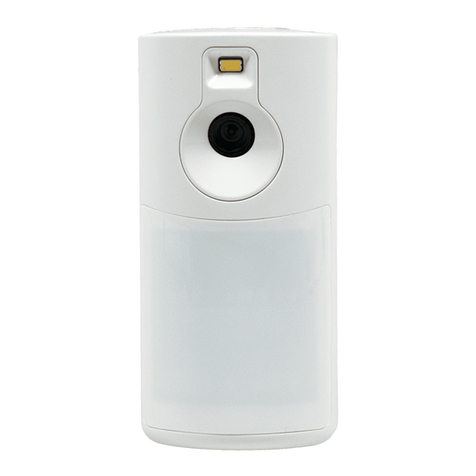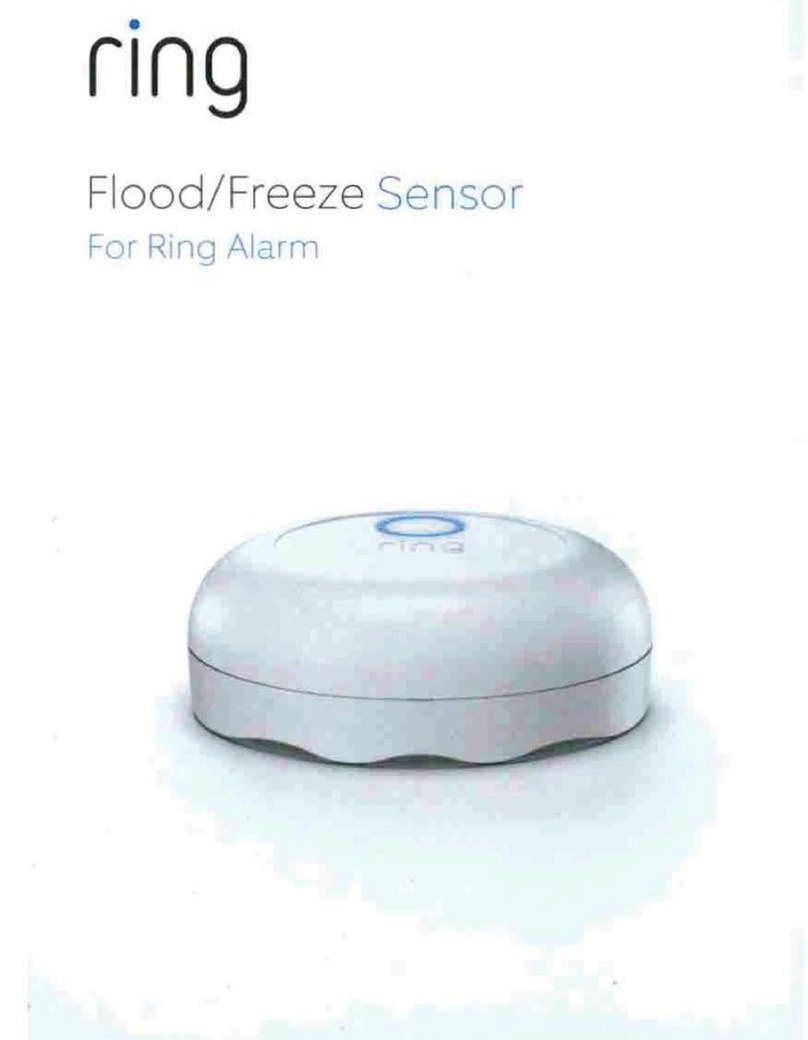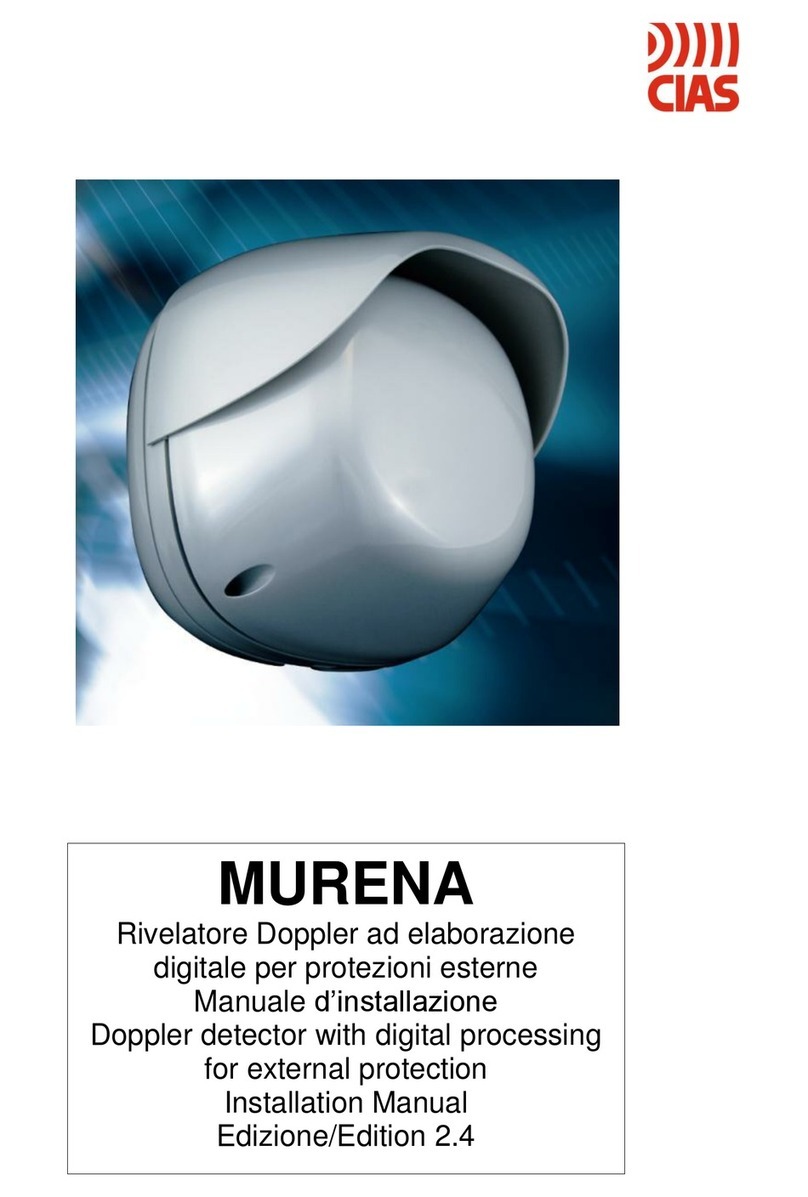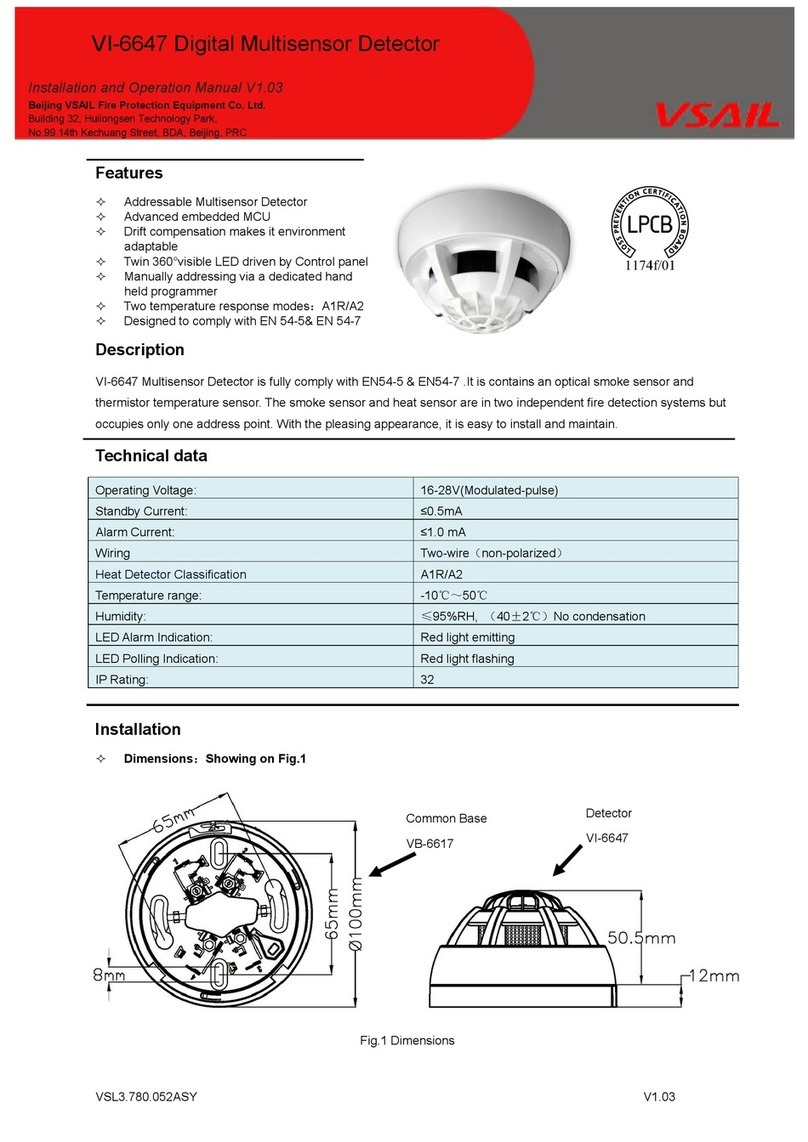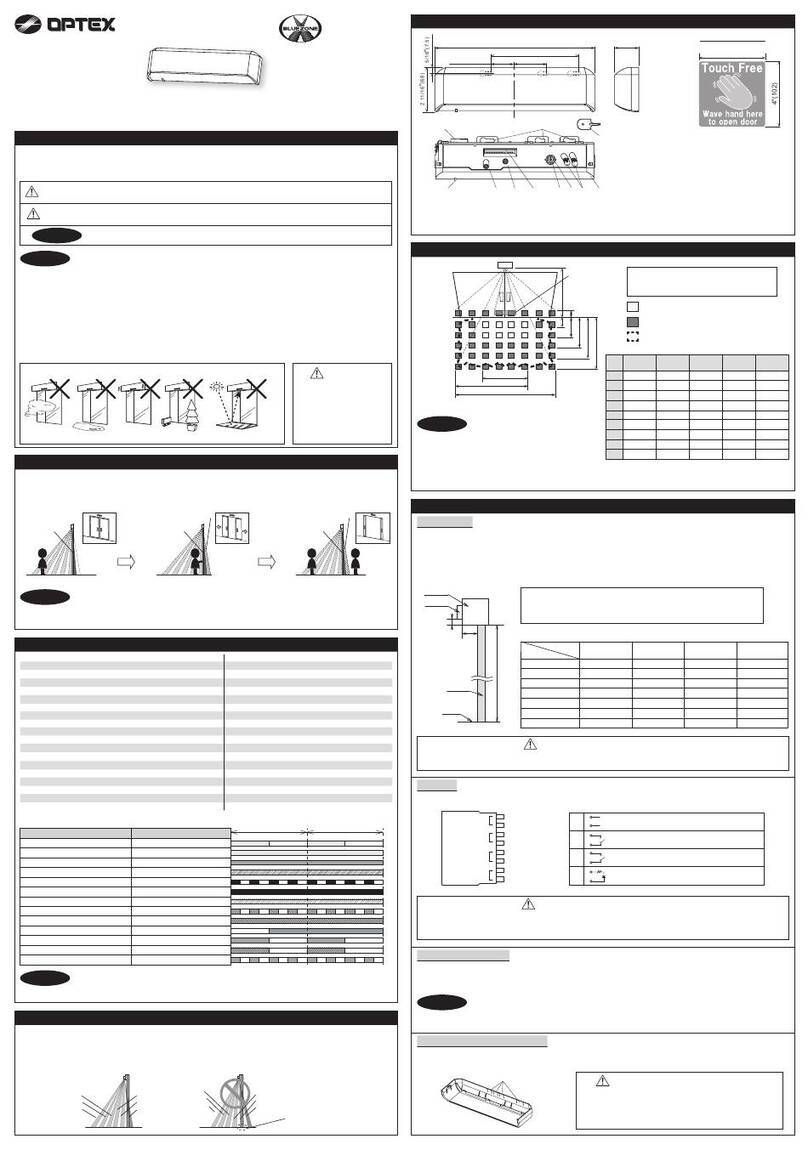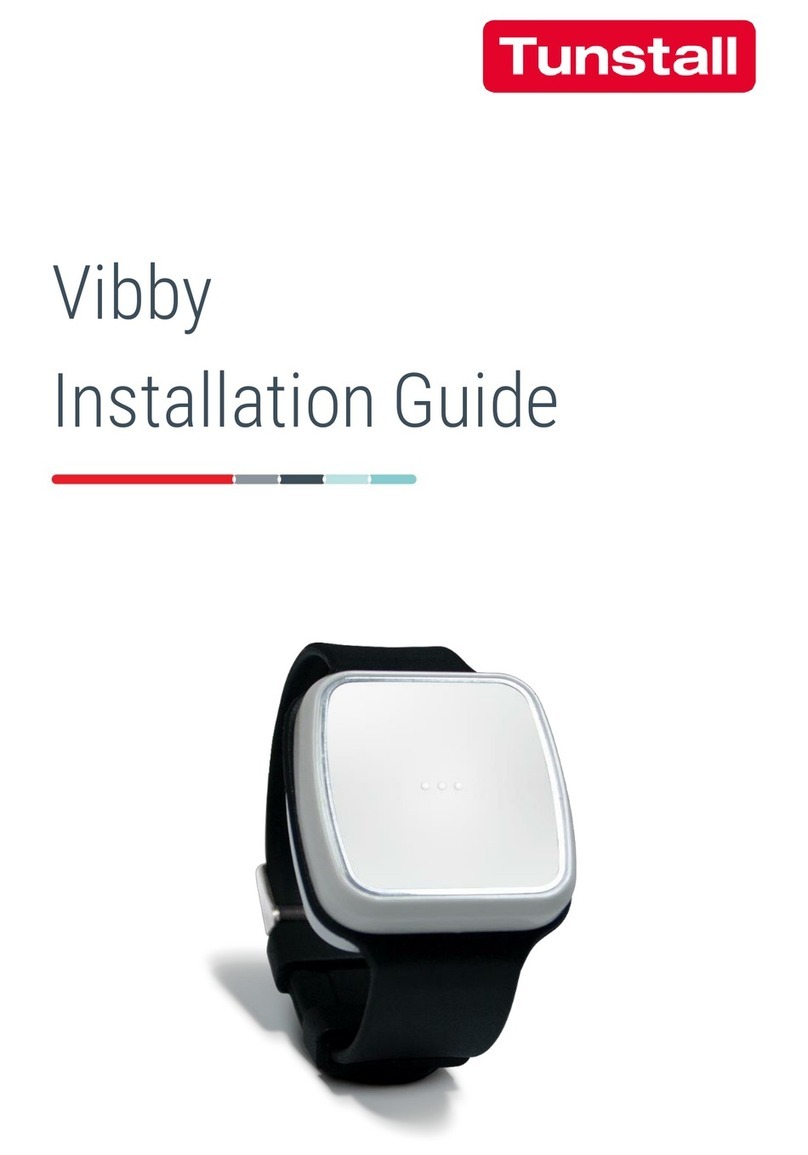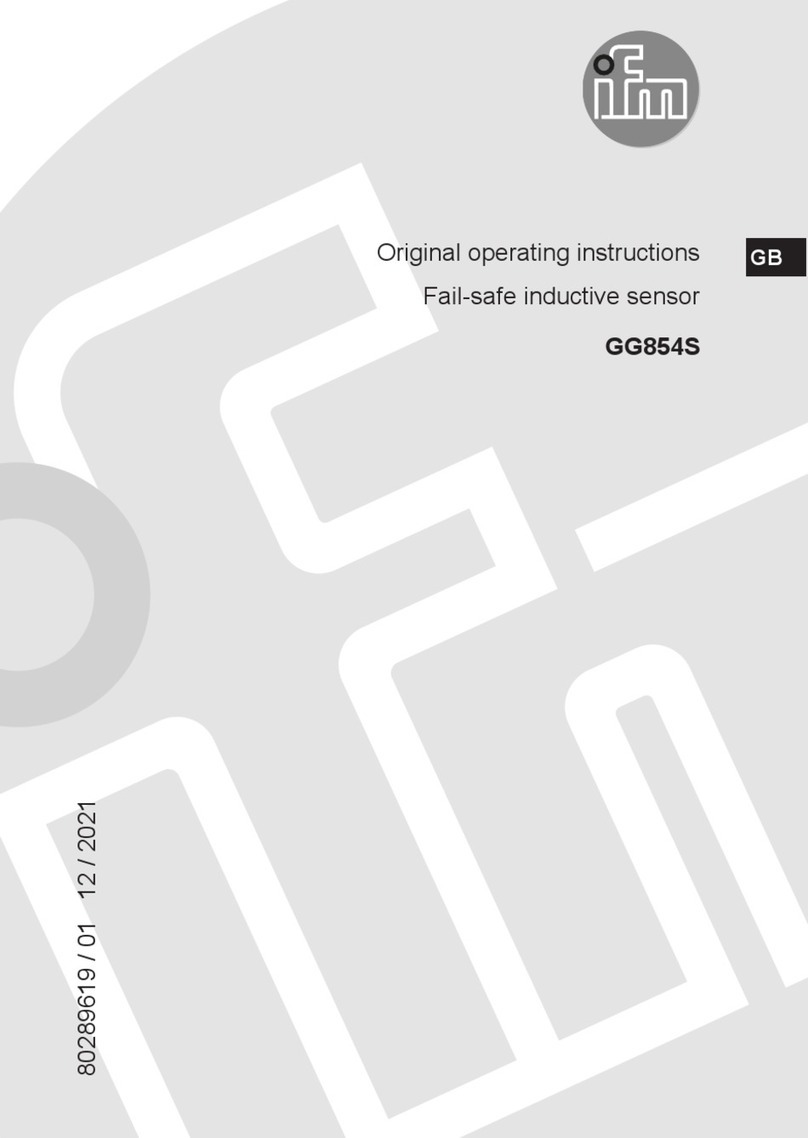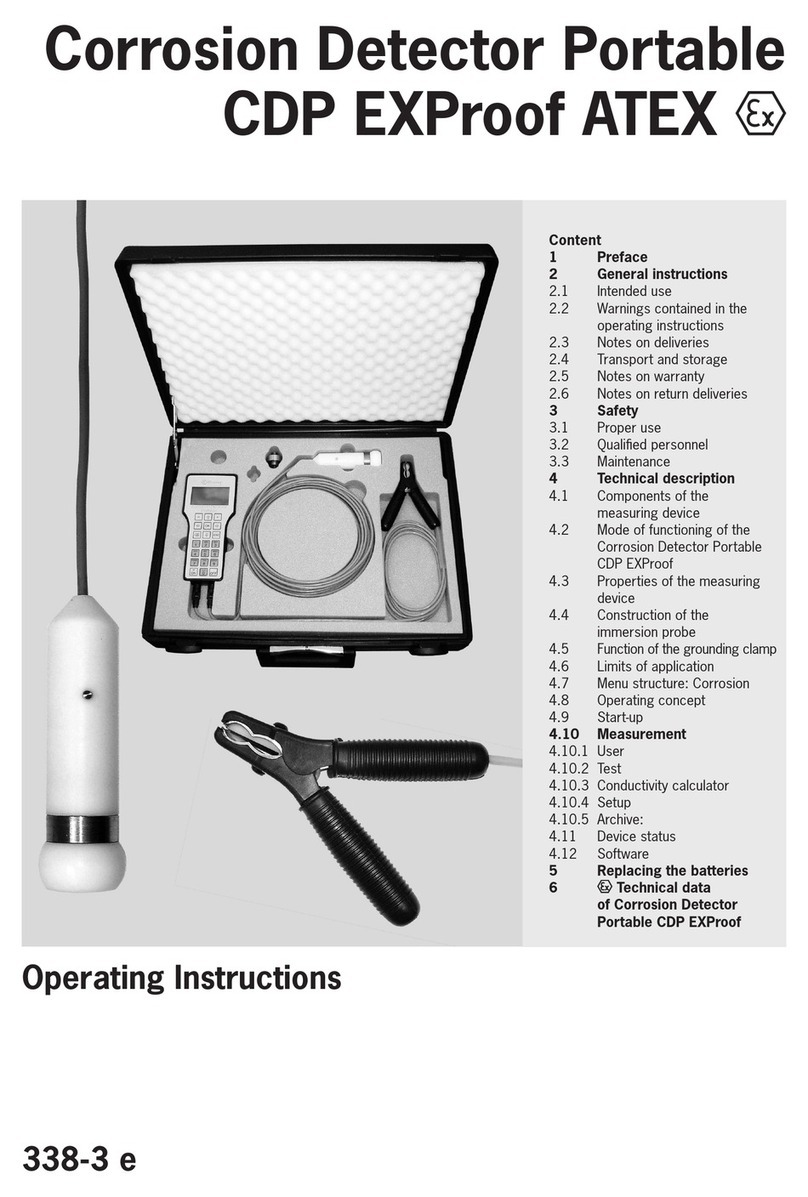Diablo DSP-7LP User manual

DSP-22-2_MAN_E 12/10/2020 Page 1 of 25 Pros Who Know Trust Diablo
User Manual
DSP-22-2
Low Power, Dual Channel Vehicle
Detector with Support for the
Free Exit Probe

DSP-22-2 User Manual Page 2 of 25 DSP-22-2_MAN_E
Contents
Figures ....................................................................................................................................................................3
1. Introduction ...........................................................................................................................................4
Functional Data.......................................................................................................................................................5
Electrical Data.........................................................................................................................................................6
Environmental Data................................................................................................................................................6
Mechanical Data.....................................................................................................................................................7
2. Features and Functions...........................................................................................................................8
Detector Reset........................................................................................................................................................8
Channel 1 –Enable / Disable (DIP Switch 9)...........................................................................................................8
Channel 1 –Sensitivity (DIP Switches 1 and 2).......................................................................................................8
Channel 1 –Normal Sensitivity / Sensitivity Boost (DIP Switch 3) .........................................................................9
Channel 1 –Frequency (S3 DIP Switches 1 and 2)..................................................................................................9
Channel 2 –Enable / Disable (DIP Switch 10).........................................................................................................9
Channel 2 –Sensitivity (DIP Switches 4 and 5).......................................................................................................9
Channel 2 –Normal Sensitivity / Sensitivity Boost (DIP Switch 6) .......................................................................10
Channel 2 –Presence / Pulse (DIP Switch 7)........................................................................................................10
Channel 2 –Loop / Probe (DIP Switch 8)..............................................................................................................11
Channel 2 –Frequency (S3 DIP Switches 3 and 4)................................................................................................11
Indicators..............................................................................................................................................................12
3. Installation...........................................................................................................................................15
General Rules and Best Practices for Inductive Loops .........................................................................................15
Detector Installation.............................................................................................................................................16
Loop Installation...................................................................................................................................................17
Free Exit Probe Installation...................................................................................................................................20
4. Troubleshooting ...................................................................................................................................22
No Power LED .......................................................................................................................................................22
Detect LED Flashes On Once Every Two Seconds.................................................................................................22
Detect LED Flashes On Twice Every Two Seconds................................................................................................22
Detect LED Flashes at the Same Time as the Power LED every Two Seconds......................................................23
Power LED Intermittently Comes On (Not Once Every 2 Seconds)......................................................................23
Detect LED Intermittently Comes On / Stays On Without a Vehicle Present.......................................................23
Detect LED Will Not Come On With a Vehicle Present.........................................................................................24
Detect 1 and Detect 2 LEDs Flash Back and Forth................................................................................................25

DSP-22-2 User Manual Page 3 of 25 DSP-22-2_MAN_E
Figures
Figure 1: Product Views..............................................................................................................................................4
Figure 2: Physical Dimensions ....................................................................................................................................7
Figure 3: Loop Installation....................................................................................................................................... 19
Figure 4: Saw Cut for Home Run Exit and Chiseled Corner for Home Run Exit....................................................... 19
Figure 5 Typical Free Exit Probe Installation ........................................................................................................... 20

DSP-22-2 User Manual Page 4 of 25 DSP-22-2_MAN_E
1. Introduction
The DSP-22-2 detector is intended to be a two-channel detector that can work with both inductive loops as well
as the new Diablo Control Free Exit Probe. The detector is powered by a high-performance 8-bit microcontroller
that does not skimp on performance. The DSP-22-2 detector has a small footprint and was designed to directly
plug into many DoorKing operators.
The detector uses a 3-pin Molex connector for its power connections and the Channel 1 solid state output. The
Channel 2 relay outputs have separate screw terminals for wired connections.
Figure 1: Product Views

DSP-22-2 User Manual Page 5 of 25 DSP-22-2_MAN_E
Functional Data
Sensitivity: Four sensitivities for each channel are user selectable.
Channel 1:
S1 DIP Switch
Sensitivity
1
2
OFF
OFF
.32% ΔL/L Low
OFF
ON
.16% ΔL/L Medium Low
ON
OFF
.08% ΔL/L Medium High
ON
ON
.04% ΔL/L High
Channel 2:
S1 DIP Switch
Sensitivity
4
5
OFF
OFF
.32% ΔL/L Low
OFF
ON
.16% ΔL/L Medium Low
ON
OFF
.08% ΔL/L Medium High
ON
ON
.04% ΔL/L High
Frequency Settings: There are four frequency settings available. The actual loop frequency is
dependent on loop circuit inductance.
Channel 1:
S3 DIP Switch
Frequency
1
2
OFF
OFF
High
ON
OFF
Medium High
OFF
ON
Medium Low
ON
ON
Low
Channel 2:
S3 DIP Switch
Frequency
3
4
OFF
OFF
High
ON
OFF
Medium High
OFF
ON
Medium Low
ON
ON
Low
B Pulse Output: 250ms ±15ms.
Response Time: 181 ms typical. 314 ms worst case.
Vehicle Hold Time: Both channels will use an extended presence mode of operation. This mode
allows very weak detections to be held for about 15 minutes. Strong detections
can be held for very long periods of time (days or even weeks) as long as power
is not interrupted.

DSP-22-2 User Manual Page 6 of 25 DSP-22-2_MAN_E
Electrical Data
Loop Inductance: 20 microhenries to 1500 microhenries (including lead-in inductance). Not all
frequency settings are available at inductances below 30 microhenries.
Operating Voltage: 14 volts to 27 volts DC
Solid State Output Rating: Maximum Output Current: 250 milliamps
Maximum Pull-Up Voltage: 30 volts
Maximum Voltage Drop Across Active Output: 0.3 volts
Relay Output Rating: 30 VDC, 2 amps (resistive)
110 VDC, 0.3 amps (resistive)
125 VAC, 0.5 amps (resistive)
Current Draw: No Channel in Detect 1.62 milliamps typical @ 20VDC.
Channel 1 in Detect 23.94 milliamps typical @ 20VDC.
Channel 2 in Detect 30.75 milliamps typical @ 20VDC.
Both Channels in Detect 33.60 milliamps typical @ 20VDC.
Environmental Data
Operating Temperature: -35°F to 165°F (-37°C to 74°C)
Storage Temperature: -40°F to 176°F (-40°C to 80°C)
Humidity: Up to 95% relative humidity non-condensing

DSP-22-2 User Manual Page 7 of 25 DSP-22-2_MAN_E
Mechanical Data
Mounting Position: Any
Housing Material: Lexan
Detector Size: 4.300 inches (High) x 2.950 inches (Wide) x .820 inches (Deep)
109.22 mm (High) x 74.93 mm (Wide) x 20.83 mm (Deep)
Figure 2: Physical Dimensions

DSP-22-2 User Manual Page 8 of 25 DSP-22-2_MAN_E
2. Features and Functions
Detector Reset
When any of the DIP switches are changed, the reset button is pressed, or power is cycled to the detector, the
detector will perform a reset. The reset event will last for two seconds while the detector initiates any changes
and waits for all systems to stabilize.
All three LEDs will turn off for 500 milliseconds at the start of the reset event. After that, the Detect 1 and Detect
2 LEDs will flash according to their fail-safe or fail-secure mode of operation. A flash rate that is the same as the
power LED indicates the output is operating as fail-safe. A much faster flash rate indicates that the output is
operating in the fail-secure mode.
NOTE: If a vehicle is over a loop during the reset period it will not be detected.
Channel 1 –Enable / Disable (DIP Switch 9)
Channel 1 has a DIP switch to enable or disable the channel. For those situations where channel 1 is not needed,
the channel can be disabled by setting DIP switch 9 to the OFF position which will turn off the channel 1 LED and
turn off the channel 1 output. The factory default is enabled (DIP switch 9 ON).
Channel 1 –Sensitivity (DIP Switches 1 and 2)
Channel 1 has four possible sensitivity levels. In most situations the sensitivity setting medium high (DIP switch 1
OFF and DIP switch 2 ON) will work effectively. For those situations where this setting is not sensitive enough,
raise the sensitivity. For those situations where the detector is overly sensitive, lower the sensitivity one level at
a time until the desired performance is obtained. Remember that semi-trucks look much smaller than a car. So,
do not set or test the sensitivity using a passenger vehicle if semi-truck traffic will be seen over the loop. The
factory default is low (DIP switch 1 OFF and DIP switch 2 OFF).
Like most inductive loop vehicle detectors, the DSP-22-2 directly measures the change in frequency of the loop
and from there, calculates the change in inductance when a vehicle interacts with it. The change in inductance is
measured as %ΔL/L (reads as “percent delta L over L”).
For the four sensitivities, the detection thresholds are:
DIP Switch
Channel 1 Sensitivity
1
2
OFF
OFF
.32% ΔL/L Low
OFF
ON
.16% ΔL/L Medium Low
ON
OFF
.08% ΔL/L Medium High
ON
ON
.04% ΔL/L High

DSP-22-2 User Manual Page 9 of 25 DSP-22-2_MAN_E
Channel 1 –Normal Sensitivity / Sensitivity Boost (DIP Switch 3)
Each channel of the detector has a user selectable feature that increases the sensitivity of the detector after initial
detection. This feature is most often used to allow a detector to have a lower starting sensitivity and then increase
it after a vehicle has been detected. This is useful in situations where high-bed tractor-trailer vehicles will be
passing over the loop. With this feature the detector may be able to detect the high-bed portion of the vehicle
without having to be overly sensitive and susceptible to false detections. NOTE: If detection of high-bed tractor-
trailers is required, correctly sized loops must be used.
DIP
Switch 3
Function
OFF
Channel 1 Normal Sensitivity
ON
Channel 1 Sensitivity Boost
Channel 1 –Frequency (S3 DIP Switches 1 and 2)
When loops are installed sufficiently far apart, any two loops will not interfere with each other. However, if two
loops are fairly close together, say two to four feet apart, the inductive fields may couple together and may
interact causing intermittent false detections. The main variables for inductive coupling are loop size, distance
between loops, and the loop frequency. Loops that are connected to the same DSP-22-2 detector can not interfere
with each other, as the detector will only turn on one of the loops at any point in time (this is referred to as
scanning). To aid in mitigating inductive coupling, each DSP-22-2 unit comes with two frequency switches for each
channel. They are binary coded allowing up to four different operating frequencies.
If there are suspicions that loops are interacting, change one of the detector’s frequency settings for the suspect
channel so that their inherent frequencies are sufficiently different as to no longer interact. If the loops are the
same size and number of turns, setting onechannel to high and the other channel to low will provide the maximum
frequency separation.
DIP Switch
Frequency
1
2
OFF
OFF
Channel 1 High
OFF
ON
Channel 1 Medium High
ON
OFF
Channel 1 Medium Low
ON
ON
Channel 1 Low
Channel 2 –Enable / Disable (DIP Switch 10)
Channel 2 has a DIP switch to enable or disable the channel. For those situations where channel 2 is not needed,
the channel can be disabled by setting DIP switch 10 to the OFF position which will turn off the channel 2 LED and
turn off the channel 2 output. The factory default is enabled (DIP switch 10 ON).
Channel 2 –Sensitivity (DIP Switches 4 and 5)
Channel 1 has four possible sensitivity levels. In most situations the sensitivity setting medium high (DIP switch 1
OFF and DIP switch 2 ON) will work effectively. For those situations where this setting is not sensitive enough,

DSP-22-2 User Manual Page 10 of 25 DSP-22-2_MAN_E
raise the sensitivity. For those situations where the detector is overly sensitive, lower the sensitivity one level at
a time until the desired performance is obtained. Remember that semi-trucks look much smaller than a car. So,
do not set or test the sensitivity using a passenger vehicle if semi-truck traffic will be seen over the loop. The
factory default is low (DIP switch 1 OFF and DIP switch 2 OFF).
Like most inductive loop vehicle detectors, the DSP-22-2 directly measures the change in frequency of the loop
and from there, calculates the change in inductance when a vehicle interacts with it. The change in inductance is
measured as %ΔL/L (reads as “percent delta L over L”).
For the four sensitivities, the detection thresholds are:
DIP Switch
Channel 2 Sensitivity
4
5
OFF
OFF
.32% ΔL/L Low
OFF
ON
.16% ΔL/L Medium Low
ON
OFF
.08% ΔL/L Medium High
ON
ON
.04% ΔL/L High
Channel 2 –Normal Sensitivity / Sensitivity Boost (DIP Switch 6)
Each channel of the detector has a user selectable feature that increases the sensitivity of the detector after initial
detection. This feature is most often used to allow a detector to have a lower starting sensitivity and then increase
it after a vehicle has been detected. This is useful in situations where high-bed tractor-trailer vehicles will be
passing over the loop. With this feature the detector may be able to detect the high-bed portion of the vehicle
without having to be overly sensitive and susceptible to false detections. NOTE: If detection of high-bed tractor-
trailers is required, correctly sized loops must be used.
DIP
Switch 6
Function
OFF
Channel 2 Normal Sensitivity
ON
Channel 2 Sensitivity Boost
Channel 2 –Presence / Pulse (DIP Switch 7)
The operating mode for channel 2 is selected with DIP switch 7 (Presence or Pulse) and affected by the setting of
DIP switch 8 (Loop or Probe). Presence detection for channel 2 is only available in the inductive loop mode of
operation (DIP switch 8 OFF). If channel 2 is in the probe mode of operation only pulse on entry operation is
available regardless of the setting of DIP switch 7.
In the Presence mode of operation, once activated, the output will remain activated for as long as a vehicle is
detected over the loop. After four minutes of continuous detection, the detector will begin a proprietary
algorithm that is designed to be able to reliably detect the vehicle for long periods of time (days or even weeks)
while still being able to drop the detection once the vehicle exits the loop.
When the probe mode of operation is selected (DIP switch 8 ON), pulse on entry is the only detection mode of
operation for Channel 2. If DIP switch 8 is OFF and DIP switch 7 is ON, Channel 2 is in the pulse mode.

DSP-22-2 User Manual Page 11 of 25 DSP-22-2_MAN_E
When Channel 2 is in the pulse mode of operation, the pulse generated by the output will be 250 milliseconds
long. There are slight differences between the probe pulse mode (DIP switch 8 ON) and the pulse mode (DIP
switch 7 ON). So, they will be explained individually.
If DIP switch 7 is ON and DIP switch 8 is OFF, the way the pulse mode operates is commonly referred to as Pulse
on Entry. In Pulse on Entry mode, the Channel 2 Output will pulse when a vehicle first enters the loop. The output
will not pulse again until the vehicle has vacated the loop. After the pulse has been output, the Detect 2 LED will
flicker (a very fast flash that is not at full brightness). This is a visual indication that the pulse has already been
output but the loop is still occupied, and no further pulses can be output until the loop is no longer occupied.
If DIP switch 8 is ON, the way the pulse mode operates is commonly referred to as Pulse with a 1 second retune.
In this mode, the Channel 2 Output will pulse when a vehicle first enters the loop. The channel will then wait 1
seconds and retune (reset) that channel. In the probe mode of operation, the detector will only hold a detection
for 1 second. Therefore, if a vehicle stays over the probe for more than 1 second it may generate additional pulses
for the same vehicle.
DIP
Switch 7
Function
OFF
Channel 2 Presence Mode
ON
Channel 2 Pulse Mode
Channel 2 –Loop / Probe (DIP Switch 8)
The DSP-22-2 is capable of operating with either a standard inductive loop or the new mini-loop (magnetometer).
As usual, the inductive loop operates in both presence and pulse modes. However, the mini-loop (magnetometer)
can only operate in pulse mode and will automatically override any settings to the contrary. The factory default
is the inductive loop mode.
DIP
Switch 8
Sensor Type
OFF
Channel 2 Inductive Loop
ON
Channel 2 Free-Exit Probe
NOTE: In the probe mode of operation the Channel 2 will only hold a detection for 1 second. Therefore, if a vehicle
stays over the sensor for more than 1 second it may generate additional pulses for the same vehicle.
Channel 2 –Frequency (S3 DIP Switches 3 and 4)
When loops are installed sufficiently far apart, any two loops will not interfere with each other. However, if two
loops are fairly close together, say two to four feet apart, the inductive fields may couple together and may
interact causing intermittent false detections. The main variables for inductive coupling are loop size, distance
between loops, and the loop frequency. Loops that are connected to the same DSP-22-2 detector can not interfere
with each other, as the detector will only turn on one of the loops at any point in time (this is referred to as
scanning). To aid in mitigating inductive coupling, each DSP-22-2 unit comes with two frequency switches for each
channel. They are binary coded allowing up to four different operating frequencies.

DSP-22-2 User Manual Page 12 of 25 DSP-22-2_MAN_E
If there are suspicions that loops are interacting, change one of the detector’s frequency settings for the suspect
channel so that their inherent frequencies are sufficiently different as to no longer interact. If the loops are the
same size and number of turns, setting onechannel to high and the other channel to low will provide the maximum
frequency separation.
DIP Switch
Frequency
3
4
OFF
OFF
Channel 2 High
OFF
ON
Channel 2 Medium High
ON
OFF
Channel 2 Medium Low
ON
ON
Channel 2 Low
Indicators
The DSP-22-2 is equipped with three (3) LED indicators: Power (Green), Detect 1 (Red), and Detect 2 (Red).
Power LED –The green power LED indicates these possible states:
Off The voltage applied to the detector is less than the minimum display
voltage of approximately 3 volts. The LED will be off.
Reset At the start of a reset event (a DIP switch change, sensitivity change, or
power cycle) the LED will turn off for 500 milliseconds, on for 500
milliseconds, off for 500 milliseconds, and then display its normal state.
High Speed Operation The LED is always on when the detector is in its high-speed mode of
operation.
Low Power Operation The LED will blink on once every 2 seconds when the detector is in its low
power mode of operation.
Detect 1 LED –The red Detect 1 LED is used to display the status of Channel 1. There are several different
statuses that can be displayed on this LED:
Off No vehicle present in the detection area and the loop is functioning
normally and there has not been a prior fault in the last week.
Reset in Fail-safe At the start of a reset event (a DIP switch change, sensitivity change, or
power cycle) the LED will turn off for 500 milliseconds, on for 500
milliseconds, off for 500 milliseconds, on for 500 milliseconds, and then
finally display its normal state.
Reset in Fail-secure At the start of a reset event (a DIP switch change, sensitivity change, or
power cycle) the LED will turn off for 500 milliseconds, on for 500
milliseconds, blink repeatedly with 50 milliseconds on followed by 50
milliseconds off for one second, and then display its normal state.

DSP-22-2 User Manual Page 13 of 25 DSP-22-2_MAN_E
Detect The LED is on constantly when a vehicle is detected.
Open Loop When the detector senses that the loop is open, or the inductance is too
high, the LED will flash once every two seconds repeatedly, for the
duration of the fault. If the fault is corrected the LED will display the
appropriate Prior Fault indication.
Shorted Loop When the detector senses that a loop is shorted, or the inductance is too
low, the LED will flash twice every two seconds repeatedly, for the
duration of the fault. If the fault is corrected the LED will display the
appropriate Prior Fault indication.
Large Change Fault When the detector senses that a loop is experiencing a large inductance
change (greater than 25%), the LED will flash three times every two
seconds repeatedly, for the duration of the fault. If the fault is corrected
the LED will display the appropriate Prior Fault indication.
Prior Fault The detector is equipped with the ability to remember prior faults that
have occurred since the last power interruption or reset (changing a DIP
switch or the sensitivity). The detector will hold this status for one week
and then automatically clear the status. In the high-speed mode of
operation (green LED is ON) and the channel is not in detect, the LED will
flash on one, two, or three times depending upon the prior failure type.
When the detector is in the low power mode (Green LED flashes on once
every 2 seconds), the channel Detect LED will flash on at the same time.
Detect 2 LED –The red Detect 2 LED is used to display the status of Channel 2. There are several different
statuses that can be displayed on this LED:
Off No vehicle present in the detection area and the loop is functioning
normally and there has not been a prior fault in the last week.
Reset in Fail-safe At the start of a reset event (a DIP switch change, sensitivity change, or
power cycle) the LED will turn off for 500 milliseconds, on for 500
milliseconds, off for 500 milliseconds, on for 500 milliseconds, and then
finally display its normal state.
Reset in Fail-secure At the start of a reset event (a DIP switch change, sensitivity change, or
power cycle) the LED will turn off for 500 milliseconds, on for 500
milliseconds, blink repeatedly with 50 milliseconds on followed by 50
milliseconds off for one second, and then display its normal state.
Detect The LED is on constantly when a vehicle is detected.
Pulse Occupancy If Channel 2 is configured for a pulse mode of operation while operating
in the loop mode, and a vehicle is being detected but Output 2 is not

DSP-22-2 User Manual Page 14 of 25 DSP-22-2_MAN_E
activated the LED shall display the flicker indication. The flicker display is
a very fast flashing at a lower level of brightness. In the Pulse mode this
occurs when the entry pulse has been generated and the vehicle is still
over the sensor.
Open Loop When the detector senses that the loop is open, or the inductance is too
high, the LED will flash once every two seconds repeatedly, for the
duration of the fault. If the fault is corrected the LED will display the
appropriate Prior Fault indication.
Shorted Loop When the detector senses that a loop is shorted, or the inductance is too
low, the LED will flash twice every two seconds repeatedly, for the
duration of the fault. If the fault is corrected the LED will display the
appropriate Prior Fault indication.
Large Change Fault When the detector senses that a loop is experiencing a large inductance
change (greater than 25%), the LED will flash three times every two
seconds repeatedly, for the duration of the fault. If the fault is corrected
the LED will display the appropriate Prior Fault indication.
Prior Fault The detector is equipped with the ability to remember prior faults that
have occurred since the last power interruption or reset (changing a DIP
switch or the sensitivity). The detector will hold this status for one week
and then automatically clear the status. In the high-speed mode of
operation (green LED is ON) and the channel is not in detect, the LED will
flash on one, two, or three times depending upon the prior failure type.
When the detector is in the low power mode (Green LED flashes on once
every 2 seconds), the channel Detect LED will flash on at the same time.
Detect 1 LED and Detect 2 LED –The red Detect LEDs will flash back and forth when neither channel is
enabled (DIP switches 9 & 10 are both set to OFF). Both channel outputs will be off while this indication
occurs. This is not a normal operating mode but may be used during troubleshooting of the gate control
system. This unique display is meant to remind the technician not to leave the detector in this mode.

DSP-22-2 User Manual Page 15 of 25 DSP-22-2_MAN_E
3. Installation
General Rules and Best Practices for Inductive Loops
Before beginning the installation, it is important to make that the loop you are about to use is appropriate for this
installation. Here are some general rules and best practices that will help you ensure that the loop you use will
have the desired performance and a long life.
1. The preferred insulation material for loop wire is cross-linked polyethylene (XHHN or XHHW are types of
this wire). Wire with PVC insulation should never be used. This includes THHN. The cross-linked
polyethylene is a much more durable insulation and, more importantly, has a much lower moisture
absorption rate. Moisture absorption can affect loop stability.
2. Wire gauge of the loop wire has little to no impact on the sensitivity of the loop. A larger wire gauge may
help extend the life of the loop, especially in asphalt installations where heavy truck traffic is expected.
3. Wire nuts should never be used in loop connections. At a minimum wire to wire connections should be
crimped or use a screw terminal. Ideally, solder the connections.
4. Loop saw cuts should be mitered to reduce the loop wire bend angle to not exceed 45 degrees at any
location.
5. Use backer rod to hold the loop wire at the bottom of the saw cut before sealing the loop. The backer
rod should be cut into 1-inch pieces and one placed every foot or so, as needed.
6. If a loop installation will cross an expansion joint in the roadway surface some method of leaving some
slack wire at the joint should be implemented. This can be done by core drilling a 1” or larger hole where
the saw cut crosses the expansion joint and leaving a loop of wire in the hole each time you go through it
when installing the loop wire. The other option is to dip the saw at the expansion joint to make the saw
slot at least two inches deeper at the joint. Then when installing the loop wire, ensure that the wire lays
all the way at the bottom of the saw slot at the expansion joint.
7. Useable detection height of a loop is 2/3rds of the shortest leg of the loop. Therefore, if you need to
detect semi-truck trailers, no side of the loop can be shorter than 6’.
8. The approximate inductance of the loops can be calculated using the formula:
L = (P / 4) x (N + N2)
Where: L = Loop Inductance in microhenries (µH)
P = Perimeter of the loop in feet
N = Number of turns (wraps) in the loop
For example, a 6’ by 14’ loop with 2 turns would be:
L = ( (6 + 14 + 6 + 14) / 4) x (2 + 22)
L = (40 / 4) x (2 + 4)
L = 10 x 6
Loop Inductance is approximately 60µH.

DSP-22-2 User Manual Page 16 of 25 DSP-22-2_MAN_E
9. The approximate inductance of the lead-in cable can be calculated using a value of .22 µH per foot for
lead-in cable.
100’ x .22 µH = 22 µH of inductance in 100’ of lead-in cable.
10. The ratio of loop inductance to lead-in inductance should be 2 to 1 for a well-designed installation. Since
the vehicle to be detected can only influence the loop inductance, letting the lead-in inductance get close
to the loop inductance will effectively lower the sensitivity of the loop. This is usually only an issue when
the loop is 50’ or more away from the detector. If you do have a long lead-in, additional turns should be
added to the loop until the 2 to 1 ratio is satisfied.
11. The ideal loop inductance is 50 to 500 µH. Although the detector will tune to loops in the range of 20 to
1000 µH, the 20 to 50 range should be avoided to provide a more stable loop and loss of sensitivity due
to lead-in inductance. It is always better to have too much inductance than too little.
12. Lead-in wires must be twisted. Ideally, 3 to 6 twists per foot should be maintained. It is also important
that the twists are tight. An air gap between the two wires should not exist as this can cause loop stability
issues. The lead-in wires should be kept twisted until right before connection to the detector.
13. A figure 8 loop can be used in locations where electricalinterference is expected or seen. This is a standard
loop with an extra saw cut down the middle of the loop. This extra saw cut should point toward the source
of the interference as much as practical. If the source is overhead or below ground (power lines) the saw
cut should be parallel to the short side of the loop. The loop wire is placed in the saw cuts using a figure
8 motion. A figure 8 loop will have more inductance that a similar sized conventional loop.
14. If multiple loops are to be connected to the same detector there are several things to be aware of:
a. Always connect multiple loops in series. This increases the inductance and insures that a loop
failure will cause a loop fault at the detector.
b. The loops connected together must be the same size and the same number of turns. Failure to
do this will lead to the loops having different sensitivities that cannot be compensated for. This
difference in sensitivity can very large.
c. Connecting two loops together will reduce the sensitivity of each loop by half.
d. If the two loops are within 6’ of each other, the phasing of the loops should be considered. If the
loops are on the same side of a gate and are being used to increase the size of the detection zone,
the two edges closest to each other should have opposite phasing (North to South). This will
increase the sensitivity in the area between the two loops. If the loops are on opposite sides of a
gate, the loops should have the same phasing (North to North). This will decrease the sensitivity
in the area between the two loops. Especially at the middle point between the two loops, it may
be impossible to detect any object in this area. So, this phenomenon can be very useful in sliding
gate and lift gate installations.
Detector Installation
Location: The detector should be plugged in to the appropriate connector on the DoorKing operator.
Mounting: The detector will function when mounted in any orientation. Using the two holes in the detector,
secure the detector in place.

DSP-22-2 User Manual Page 17 of 25 DSP-22-2_MAN_E
Wiring: Attach the loops to the appropriate loop screw terminals. Wire nuts should never be used at any point
in the loop circuit itself. All loop connections should be crimped or use screw terminals at a minimum and soldered
for best long-term reliability. Special attention should be paid to ensure that the loop wires remain tightly twisted
together. An air gap between the two wires for a loop may cause the detector to lock up if the wires are disturbed.
If connecting two loops to one channel of a detector, there are certain rules you should follow:
1. Always connect multiple loops in series, not parallel. A failure of one loop may not be identified if the
loops are connected in parallel.
2. The loops should be the same size, shape, and have the same number of turns. If any of these items are
different, the loops will have different sensitivities that cannot be adjusted for. The difference in
sensitivity could be very significant.
3. Do not use a wire nut to connect the wire from each loop together. Wire nuts have a spring in them and
will expand and contract with temperature. Even the slightest change in resistance can cause detector
lock-ups.
Connect the desired Out 2 outputs to the appropriate inputs on the operator.
Loop Installation
The reliability and overall performance of the detector are greatly dependent on the loop itself. Several factors
go into a good loop installation: type of wire used, loop configuration, and installation practices.
Type of Wire Used: The wire used for wiring the loop should have a jacket of cross-linked polyethylene or similar
material that has very low moisture absorption properties. This would be a wire with an XLP jacket such as XHHW.
THHN or similar wire types should never be used for loop wire.
The gauge of the wire to use depends on two factors: Distance in cable feet from the loop to the detector and
stresses the wire may see. The gauge of the wire can be 20 AWG as long as the detector is within 50 feet of the
loop in cable distance. For 50 to 100 feet, use at least 18 AWG wire. At greater than 100 feet, use a 16 AWG wire
at a minimum. If the loop is installed in asphalt and there will be heavy vehicles or stopping and starting vehicles
in the loop area, a 14 AWG or 12 AWG should be used to provide additional strength to the loop. This helps
increase the life of the loop in areas where the asphalt may slowly move and/or deform due to wear and/or
temperature.
Loop Configuration: The size and shape of the loop will determine what type of vehicles it can reliably detect.
There are many variables that come into play including loop dimensions, percent of coverage, length of lead-in
wire, number of turns in the loop area, and detection height to name just a few of them. One common rule is
that the useable field height of a loop is 2/3 of the shortest leg of the loop. So, if you plan on using a 2.5’ x 6’ loop,
the expected useable detection height would be 20” (The shortest leg is 2.5’ or 30”, 30” x 2 = 60”, 60” / 3 = 20”).
If the installation requires the detection of motorcycles as well as vehicles, the loop should go to within one foot
of the curb or roadway edge, whichever is present. If only motor vehicle detection is required, within three feet
of the curb or roadway edge is all that is required.

DSP-22-2 User Manual Page 18 of 25 DSP-22-2_MAN_E
The number of turns to use in a loop is dependent on the size of the loop and length of the lead-in.Rather than
dive into all of the calculations to arrive at a value, we will just give you a table of safe values based on the number
of square feet in the loop (length times width in feet). If you are unsure about your particular installation, call tech
support for guidance.
Loop Size in Square Feet
Recommended Turns
for <100’ of Lead-in
Recommended Turns for
100’ to 199’ of Lead-in
Recommended Turns for
200’ to 299’ of Lead-in
5 to 6 square feet
7
8
10
7 to 9 square feet
6
7
9
10 to 15 square feet
5
6
8
16 to 23 square feet
4
5
6
24 to 54 square feet
3
4
5
55 to 150 square feet
2
3
3
Installation Practices: Permanent loops should be installed into the road surface by cutting slots into the road
surface using a saw with an appropriate cutting disk for the road surface.
The slot cut should be wide enough that the wire being used will easily fit into the slot. This is needed so that the
loop sealant used can fully encapsulate the wire. When the wire fits tightly in the slot, the sealant may not be
able to get below the wire, leaving air pockets in the saw slot. If water finds its way in to these air pockets, over
time, freeze thaw cycles can slowly jack the loop out of the saw slot causing loop failure.
The saw slot should be deep enough that the loop wire will have a minimum of ½” of sealant over the top wire in
the slot. More is better. Going too deep with the saw cut is also a concern. Deep cuts in a road surface may
impact the structural strength of the roadway, especially if any reinforcement material is cut. Using a smaller
gauge of wire will allow for shallower saw cuts.
The corners of the loop should be crosscut at a 45°to help prevent damage to the wire insulation during
installation and temperature cycling. The angled cuts should be at least 9” back from where the corner would be.
The saw cuts should not go any further than necessary to ensure that the saw slots are at full depth where they
meet.
Special consideration should be given to where the home run saw cut meets the loop saw cuts. Here either an
additional saw cut should be made as shown in Detail A or the inside of the sharp corner should be removed with
a chisel as shown in Detail B.
Once the saw slot has been cut, the slot should be cleaned of all loose material. High-pressure air should be
directed in to the saw slot to remove all debris. This will also help remove dust from the saw cutting operation
from the sides of the saw slot. This will allow better adhesion of the loop sealant to the saw slot.

DSP-22-2 User Manual Page 19 of 25 DSP-22-2_MAN_E
Figure 3: Loop Installation
Figure 4: Saw Cut for Home Run Exit and Chiseled Corner for Home Run Exit
BACKER ROD
PIECE
LOOP WIRE
SAW
CUTS
DETAIL A
DETAIL B

DSP-22-2 User Manual Page 20 of 25 DSP-22-2_MAN_E
The loop wire should be installed as a continuous piece of wire from the detector to the loop, all of the turns in
the loop, and back to the detector. Remember to make allowance for shrinkage in the wire length when the
portion of the wire not in the roadway surface is twisted. The twisting is important for dealing with electrical
noise. A splice of the loop wire should never be made in the roadway. If the loop wire needs to be spliced to
another cable to get to the detector, the splice should be done in a junction box and the connections should be
soldered and weatherproofed. Wire nuts should never be used at any point in the loop circuit.
In order to keep the loop wire at the bottom of the saw slot, 1” to 2” pieces of backer rod should be placed in the
saw slot every 1 to 2 feet. The backer rod should be sized such that it fits snugly in the saw slot. Use a blunt object
(not a screwdriver) to press the backer rod pieces down into the saw slot as far as they will go. Keeping the loop
wire at the bottom of the saw slot allows the loop sealant to provide the maximum amount of protection possible
from foreign object penetration. Never use a continuous piece of backer rod over the loop, as this would prevent
the loop sealant from encapsulating the loop wire.
The loop sealant used should be appropriate for the roadway surface that was cut. Generally, epoxy or polyester
based sealants are used for concrete surfaces and polyester or polyurethane based sealants are used for asphalt
surfaces. However, these are not hard guidelines and specific circumstances will determine which type of sealant
should be used.
Once the loop wire leaves the saw slot it should be twisted at least three times per foot. More is better. The
twists should be kept tight to be most effective in reducing the effects of electrical interference.
Free Exit Probe Installation
Figure 5 Typical Free Exit Probe Installation
This manual suits for next models
4
Table of contents
Other Diablo Security Sensor manuals

